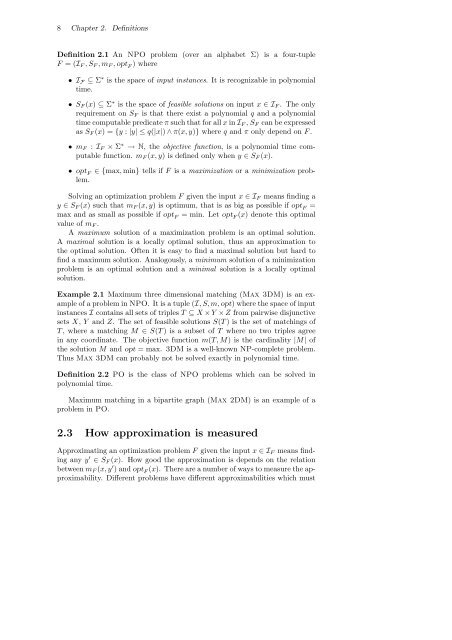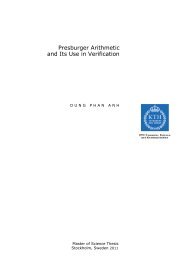On the Approximability of NP-complete Optimization Problems
On the Approximability of NP-complete Optimization Problems
On the Approximability of NP-complete Optimization Problems
You also want an ePaper? Increase the reach of your titles
YUMPU automatically turns print PDFs into web optimized ePapers that Google loves.
8 Chapter 2. Definitions<br />
Definition 2.1 An <strong>NP</strong>O problem (over an alphabet Σ) is a four-tuple<br />
F =(IF ,SF ,mF , opt F )where<br />
•IF ⊆ Σ ∗ is <strong>the</strong> space <strong>of</strong> input instances. It is recognizable in polynomial<br />
time.<br />
• SF (x) ⊆ Σ ∗ is <strong>the</strong> space <strong>of</strong> feasible solutions on input x ∈IF .Theonly<br />
requirement on SF is that <strong>the</strong>re exist a polynomial q and a polynomial<br />
time computable predicate π such that for all x in IF , SF can be expressed<br />
as SF (x) ={y : |y| ≤q(|x|) ∧ π(x, y)} where q and π only depend on F .<br />
• mF : IF × Σ ∗ → N, <strong>the</strong>objective function, is a polynomial time computable<br />
function. mF (x, y) is defined only when y ∈ SF (x).<br />
• opt F ∈{max, min} tells if F is a maximization or a minimization problem.<br />
Solving an optimization problem F given <strong>the</strong> input x ∈IF means finding a<br />
y ∈ SF (x) such that mF (x, y) is optimum, that is as big as possible if opt F =<br />
max and as small as possible if opt F =min. Letopt F (x) denote this optimal<br />
value <strong>of</strong> mF .<br />
A maximum solution <strong>of</strong> a maximization problem is an optimal solution.<br />
A maximal solution is a locally optimal solution, thus an approximation to<br />
<strong>the</strong> optimal solution. Often it is easy to find a maximal solution but hard to<br />
find a maximum solution. Analogously, a minimum solution <strong>of</strong> a minimization<br />
problem is an optimal solution and a minimal solution is a locally optimal<br />
solution.<br />
Example 2.1 Maximum three dimensional matching (Max 3DM) isanexample<br />
<strong>of</strong> a problem in <strong>NP</strong>O. It is a tuple (I,S,m,opt) where <strong>the</strong> space <strong>of</strong> input<br />
instances I contains all sets <strong>of</strong> triples T ⊆ X × Y × Z from pairwise disjunctive<br />
sets X, Y and Z. The set <strong>of</strong> feasible solutions S(T ) is <strong>the</strong> set <strong>of</strong> matchings <strong>of</strong><br />
T ,whereamatchingM ∈ S(T ) is a subset <strong>of</strong> T where no two triples agree<br />
in any coordinate. The objective function m(T,M) is <strong>the</strong> cardinality |M| <strong>of</strong><br />
<strong>the</strong> solution M and opt =max. 3DM is a well-known <strong>NP</strong>-<strong>complete</strong> problem.<br />
Thus Max 3DM can probably not be solved exactly in polynomial time.<br />
Definition 2.2 PO is <strong>the</strong> class <strong>of</strong> <strong>NP</strong>O problems which can be solved in<br />
polynomial time.<br />
Maximum matching in a bipartite graph (Max 2DM) isanexample<strong>of</strong>a<br />
problem in PO.<br />
2.3 How approximation is measured<br />
Approximating an optimization problem F given <strong>the</strong> input x ∈IF means finding<br />
any y ′ ∈ SF (x). How good <strong>the</strong> approximation is depends on <strong>the</strong> relation<br />
between mF (x, y ′ )andopt F (x). There are a number <strong>of</strong> ways to measure <strong>the</strong> approximability.<br />
Different problems have different approximabilities which must

















